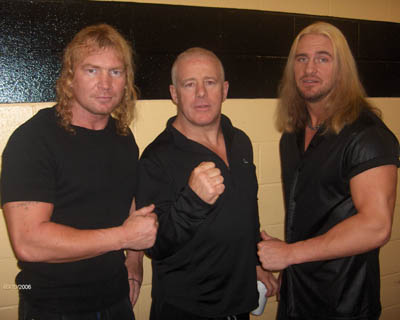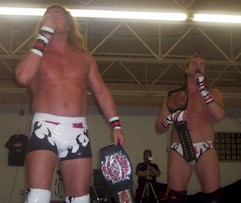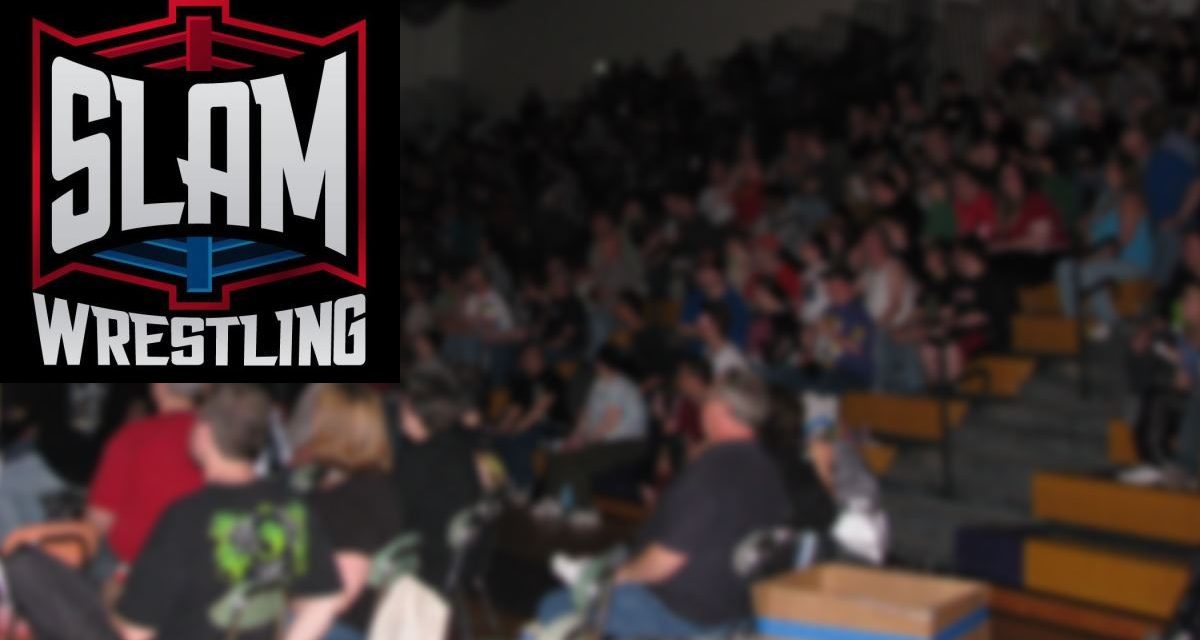Ontario’s Canadian Extreme tag team spent last Monday and Tuesday showing WWE brass their best, and won enough attention to be invited to another show in November.
WWE invited Frank Ryckman (a.k.a. Thorn) and Jason Lewis (a.k.a. CK) to its Montréal SuperShow Monday, where the two performed a dark match in front of much of the roster. The match must have gone well, because both were invited to WWE’s Ottawa tryout the next day.
The two were in fine company, joining the 20 wrestlers WWE chose from over 15,000 applicants. For two-and-a-half hours, Ryckman and Lewis, as well as the other applicants (many of whom were cut before the session ended), were run through vigorous workouts, promos, ring drills, and eventually, matches.
“It was a great experience. I had a great, great time,” Ryckman, a 6-foot-1, 232-pound Niagara Falls, Ontario-native, told SLAM! Wrestling. “It was also one hell of an experience — my legs are killing me. I feel like I squatted 600 pounds.
“But I know the direction Jay and I are going and I really believe we’re going to be signed.”
The 6-foot-2, 226-pound Lewis, born in the town of Tillsonburg in Southwestern Ontario, added that WWE invited Canadian Extreme to its November 4th Flint, Michigan SmackDown! house show.
Lewis said their recent WWE session went well, noting Fit Finlay told them he saw a lot of potential, and that Paul London, one half of the SmackDown! tag-team champions, told the pair he looked forward to getting them in the WWE tag mix and working with them.
Canadian Extreme originally got WWE’s attention after sending a tape to then WWE talent scout and coordinator Tommy Dreamer in September 2005, Lewis said. When Dreamer learned they were from Canada, he said WWE would give them a chance to show their stuff once the promotion did a booking in Canada. It was not until the SuperShow that the opportunity finally arrived.
“They were pretty excited about us,” said Ryckman.
Likewise, both he and Lewis were thrilled about the opportunity to make it to the WWE.
“I’m not really nervous about it — anxious, excited,” Lewis said days before the event. “I want to be there, do it, and show them what we have. I’m excited and ready to go.”
Ryckman was healing from a pectoral muscle tear he suffered seven weeks ago and figured he was probably only about 50 per cent, but refused to allow his injury to miss taking the opportunity. Following the tryout, Ryckman said he was sore but that the effort was well worth it.
“To me, this means everything in my life. On the 18th, all my hopes and dreams come true. Signing with them would be a bonus,” said Ryckman before the show.
The tryout was the culmination of years of hard work.

Frank Ryckman (a.k.a. Thorn), left, with Fit Finlay and Jason Lewis (a.k.a. CK)
Lewis began his training in September 1996 with Ron Hutchison in Toronto, but fallout with him led to Lewis leaving and doing indy shows. Ryckman trained in Hamilton for six months with Ernie Moore in 1999.
In the summer of 2000, the future tag-team partners met at a Renegade Wrestling Alliance show in Toronto. In February 2001, Ryckman followed Lewis to Ocala, Florida, to Dory Funk Jr.’s Funkin’ Conservatory.
When Ryckman got to Funk’s camp, he said he realized he was not as ready as he thought he was. “I think the problem is a lot of people learn how to bump and hit and they think they’re pro wrestlers. But Jay and I, we strive to be better and better.”
A good deal of knowledge was passed along at the week-long camp and Ryckman admitted there were some lessons learned that did not completely sink in for a year: “It’s an art where you’re out there trying to make it look real.”
“They did a heck of a job. Those guys were terrific,” Dory Funk Jr. said. “Jay was the more flamboyant of the two. He had very much the crowd-appealing personality. Frank, technically, did a great job for us. He was more technically able to master the moves.”
A debut on the former NWA World Heavyweight Champion’s !BANG! TV (a show available in streaming video on www.dory-funk.com) followed the training session. (Both made an appearance, although Ryckman did not wrestle because of a knee injury.)
“They both worked hard… They did an exceptional job and were completely unselfish, which is very, very important,” said Funk, a former WWE head training coach. “I’m very proud to have made a contribution to their wrestling skills.”
Four months later, Ryckman said he and Lewis started tagging together using a brother gimmick, and have been working together ever since.
A year after the Funk camp, Canadian Extreme returned to Florida to do a promotion, where they met Steve Keirn, who also works as a WWE road agent. For three days, they trained at his School of Hardknocks.
“It was really an eye opener. He taught us a lot of things,” said Lewis.
Both Funk’s and Keirn’s schools helped Lewis and Ryckman to brush up on their skills and better their abilities, Lewis said.
“We work with each other really well. We can read off each other a lot — we’ll know, he’s gonna do this, and he’s gonna do that,” Lewis said.
“I do believe we’re the best tag team in Canada… I think we’re the total package,” added Ryckman.
Ryckman noted that the NWA once ranked Canadian Extreme tenth in its tag team division among all its affiliates, including TNA.
“I was pretty proud of that,” Ryckman said.
Another major development for the team came in 2004 when Ryckman and Lewis hooked up with Ernie Todd and his Winnipeg-based Canadian Wrestling Federation (CWF) promotion. There, they worked and trained with “Pitbull” Kerry Brown, who “helped build pieces that we needed to become whole, the full package you might call it,” according to Ryckman.
“He’s amazing. Kerry, we met on Ernie’s tours and he’s probably the funniest, nicest guy I’ve met in the business so far,” Lewis said. “He does a dead-on Stu Hart impersonation. If you close your eyes, you’ll think Stu’s next to you. And the stories he’s got of Stu, he’ll have you on the floor laughing.”
Kerry taught both men how to work the ring, Ryckman and Lewis said.
“A lot of old school tag psychology. A lot of guys go out there and do spot, spot, and a lot of it, technically, doesn’t make sense,” Lewis said.
Ryckman added Brown rated Canadian Extreme as among his preferred teams to wrestle against, placing them in the company of his other favorites, The British Bulldogs and The Hart Foundation.
“It adds to our credibility that we’ve trained with real trainers,” Ryckman said, adding many wrestlers lack proper instruction.
Todd, the CWF owner and owner of the rights for AWA Canada, believed there are too many poor trainers offering their services.
“A lot of the carnie-scam mentality needs to disappear,” said Todd, who opened his own training center in September. “This is a business and it needs to be run as a business.”
He lauded Canadian Extreme for taking the time to undergo the necessary training. “I find a lot of guys watch too much wrestling on TV and think they’re wrestlers. They don’t want to go through the training, they want to take short cuts,” said Todd, who added many rush themselves into shows before they are ready.
The result is a glut of green wrestlers and a lack of experienced ones to show them the way.
“I think Winnipeg probably has 200 wrestlers and maybe 10 of those I would consider very good, top quality that would draw fans to the seats. And they’re spread around a number of promotions,” Todd said.
Todd helped give Canadian Extreme advice on how to handle inexperienced workers. “If a guy is a little bit green and hasn’t had much experience, you’ve got to control the match, especially as a heel. You don’t want to let them do things that don’t make sense. And if a guy doesn’t know how to do a hip-toss, you sure don’t want him to give you a Swanton.”
To a degree, one has to work at the other competitor’s level while still making the match entertaining. Todd lamented the lack of veterans around to guide talent, leaving inexperienced talent taking on similarly untested wrestlers in “debacles,” Todd said. “Canadian Extreme had to work with a lot of guys that were green but they’ve been able to pass on their experience and had some very good matches.”
Canadian Extreme worked at least 100 shows for him in the last three years. “They’re a very, very good tag team… Even as heels, they’re pretty popular with fans. They gelled as a team. Wrestling is a full time job for them.”
Widespread travel also helped mold Canadian Extreme into a more capable combination.
Overall, travel is a necessity for the up-and-coming wrestler. Lewis said going to various areas and wrestling different talent gives one a chance to see and learn other styles.

Thorn upfront and Ck in the back
“A lot of indy workers wrestle in one certain area and it’s the same matches over and over… I don’t think you can get much experience unless you travel,” Lewis said.
Ryckman pointed out he and Lewis have traveled extensively, through seven different provinces and all over the U.S., wrestling from Nunavut to Miami.
It was the Annual Winter Freeze tours with Todd, though, that caused the most anxiety.
Ryckman said he completed a couple of winter tours of northern Manitoba and Québec, which typically started in January and ended in April.
“They’ve been very, very scary. You’re driving over lakes,” he said. “Come April, a lot of these lakes are unthawing and you’re driving through six inches of water. One time the water was coming through the doors and you’re looking up at God saying, ‘Please!'”
Ryckman said he once drove his own van on a winter tour, battering it and returning it home in a severe case of disrepair, much to the chagrin of his wife.
“You’d think twice about driving your Ski-Doo over these roads and here you’re driving vans and trucks. But that’s wrestling,” Ryckman said. “You come back and say you’d never do it again, but come next year, you do. I’m a glutton for punishment. I’m not sure if I’ll do it again. But who knows?”
Lewis said he had never heard of a winter road before his first trip north and was surprised by what he learned. “All it is is a path carved through a forest and you’re banging your head off the roof of a van,” Lewis said, noting a fellow traveler once required 14 stitches in his head after slamming into the side of a door during a particularly rough patch of road. “We were stuck for six hours and it was minus 50. It could have been life or death. The winter roads are an experience. It’s not something I’d want to do the rest of my life. But at least I can say I did it.”
Although traveling so far and wide was costly at first when they were forced to pay out of their own pockets, Canadian Extreme’s travel and motel costs have been covered when they worked with Todd.
But in spite of good merchandise sales, day jobs are still a fact of life. Indy guys are lucky to make $20 to $50 a match after costs, Lewis said.
“If you love the business you do it. People that aren’t in it don’t understand it,” Lewis explained, pointing out wrestlers make these sacrifices to achieve their longer-term goals. “The payoff in the end, if your goal is to get to WWE, which ours is, is to get signed.”
Funk, for one, believes Ryckman and Lewis have the necessary technical skills and that intangible charisma element necessary to get signed. “I think they’re very talented, and with five years more experience (since his camp), I think they’ll do a great job for WWE. If they can demonstrate they can have a following that will buy products and fill the seats, then they (WWE) will most certainly take them and put them on contract.”
He said their ages (Ryckman is 37 and Lewis 31) should not be an issue in their success.
Although every business needs young people, “WWE is looking for mature people that can handle themselves in the business world. Their age shouldn’t be a hindrance.”
Todd said he was somewhat surprised the WWE came calling for Canadian Extreme given the promotion typically draws talent from its own development leagues, and that it is very difficult to even get the company to return phone calls.
“But they deserve it. They’ve worked hard for it,” he said.
RELATED LINKS
- Sep. 21, 2006: WWE wannabes put through paces in Ottawa

